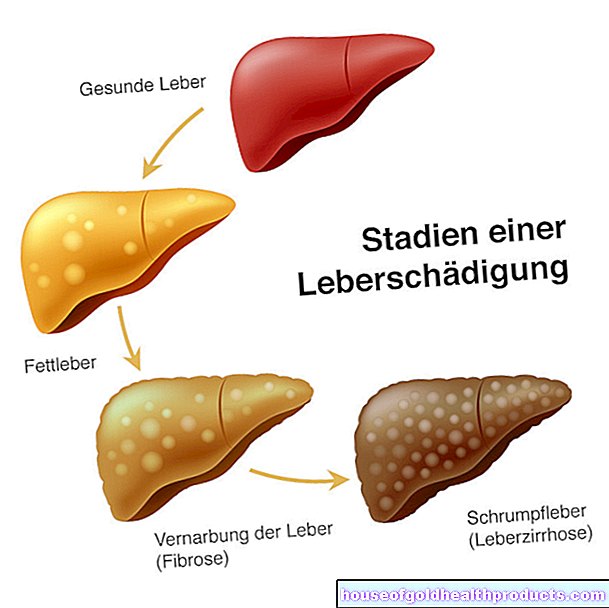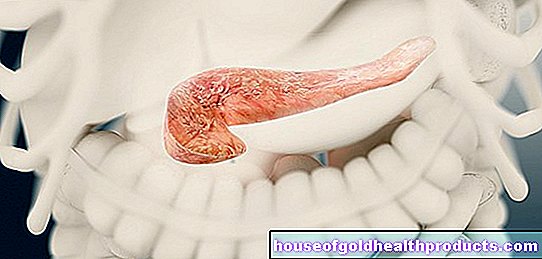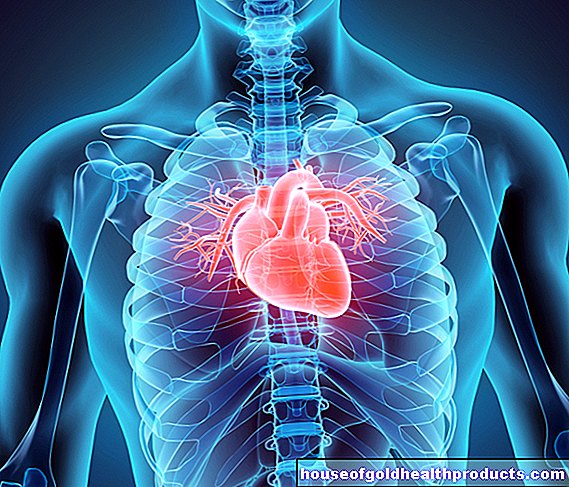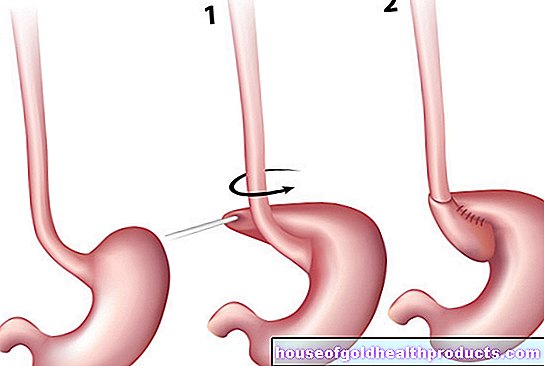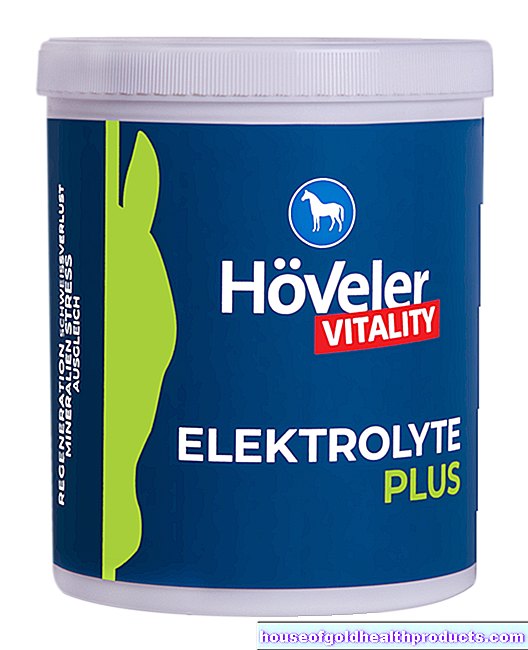Conn syndrome
All content is checked by medical journalists.Conn syndrome - medically also called primary hyperaldosteronism - is a disease in which the adrenal glands produce an increased amount of the hormone aldosterone. Aldosterone is involved in keeping blood pressure at a certain level. In Conn syndrome, the patient's blood pressure is permanently too high. Find out more here.
ICD codes for this disease: ICD codes are internationally recognized codes for medical diagnoses. They can be found, for example, in doctor's letters or on certificates of incapacity for work. E26
Conn syndrome: description
Conn syndrome (primary hyperaldosteronism) is a disease of the adrenal glands in which the blood pressure is permanently too high (hypertension). The hormone aldosterone plays an important role - one of the hormones that regulate the concentration of salts such as sodium and potassium in the blood. In Conn syndrome, the adrenal cortex produces too much aldosterone. As a result, less sodium is excreted in the urine, but more potassium. This also means that more water remains in the bloodstream - high blood pressure develops that is difficult to treat.
Primary hyperaldosteronism - the body's own production of too much aldosterone - was first described in 1955 by the US doctor Jerome Conn. For a long time, experts considered Conn's syndrome to be a very rare disease; but now it is assumed that it could be the cause of up to 13 percent of all high blood pressure cases. However, many people with Conn syndrome are not recognized because they do not have a noticeably low potassium level.
Conn syndrome is the most common cause of secondary hypertension - that is, for those cases of high blood pressure that are related to a specific underlying disease. However, the most widespread is still primary hypertension, which can be traced back to an unfavorable lifestyle and hereditary factors.
Conn syndrome: symptoms
The main symptom in Conn's syndrome is measurable high blood pressure. Primary hyperaldosteronism does not necessarily trigger noticeable symptoms. Only some of those affected complain of specific symptoms of high blood pressure:
- headache
- red and warm face
- Noise in the ears
- Nosebleeds
- Visual disturbances
- Shortness of breath
- decreased performance
However, the permanent high blood pressure in Conn syndrome can damage various organs, especially the heart, kidneys and eyes. Many sufferers develop kidney problems or cardiovascular disease over time. Your risk of hardening of the arteries (atherosclerosis or arteriosclerosis), heart attacks and strokes is even higher than that of people with primary hypertension, ie "normal" high blood pressure without disease of the adrenal glands.
About every tenth patient with Conn's syndrome also has a potassium deficiency (hypokalaemia). Potassium is a mineral that performs many important functions in the body, including muscles, digestion and regulating the heart rhythm. Too low a potassium level in the blood can lead to muscle weakness, cramps, cardiac arrhythmias, constipation, increased thirst (polydipsia) and frequent urination (polyuria) in Conn syndrome.
Conn syndrome: causes and risk factors
Conn syndrome is caused by a disorder of the adrenal cortex. This is the outer part of the adrenal glands, two small organs that sit on top of the two kidneys. The adrenal cortex is one of the most important production sites for a wide variety of hormones, the body's signaling substances. Among other things, it produces the anti-inflammatory and metabolically active cortisol, but also various sex hormones - and aldosterone.
Aldosterone works together with other hormones - renin and angiotensin - to regulate blood pressure and the body's water balance. Doctors therefore also speak of the renin-angiotensin-aldosterone system, or RAAS for short.
How the RAAS works
In simple terms, the RAAS works as follows: If the kidneys are not supplied with blood well enough for any reason (such as insufficient sodium levels, insufficient fluid intake), certain cells in the kidneys produce renin, an enzyme with hormonal effects. This enzyme splits angiotensinogen formed in the liver - the hormone angiotensin I is produced. Angiotensin I is converted into angiotensin II by another enzyme, the angiotensin converting enzyme (ACE). This in turn causes the blood vessels to contract. This increases blood pressure. At the same time, angiotensin II stimulates the adrenal cortex to produce aldosterone. Aldosterone ensures that more water and sodium remain in the body. This also increases blood pressure as the volume of blood in the vessels increases. The kidneys are supplied with better blood again and release less renin again.
Disorders of the adrenal cortex
In Conn's syndrome, the RAAS becomes unbalanced because the adrenal gland produces too much aldosterone. This can have different causes:
- a benign tumor (adenoma) of the adrenal cortex that produces aldosterone
- a slight enlargement of the adrenal glands on both sides (bilateral adrenal hyperplasia)
- unilateral enlargement of an adrenal gland (unilateral hyperplasia)
- a malignant tumor (carcinoma) of the adrenal cortex that produces aldosterone
However, unilateral hyperplasia and adrenal carcinoma are very rare causes of Conn's syndrome.
Familial hyperaldosteronism
There is very rarely a hereditary cause behind Conn's syndrome, i.e. the chronically increased aldosterone production - then one speaks of familial hyperaldosteronism of type I or type II. In type I there is a defect in the genetic material, as a result of which the pituitary gland produces too much of another messenger substance - the adrenocorticotropic hormone (ACTH). ACTH stimulates the adrenal cortex to produce aldosterone. In familial hyperaldosteronism type II, the genetic cause has not yet been clarified.
Conn syndrome: examinations and diagnosis
Conn's syndrome usually starts with a diagnosis of high blood pressure. It is not uncommon for those affected to have been in treatment for months or years before Conn's syndrome is diagnosed. Sometimes they are noticeable because the high blood pressure is difficult to control with various drugs. Most of the time, however, primary hyperaldosteronism is diagnosed if a low potassium level is noticed by typical symptoms or by chance during a blood test. Other blood values also shift in Conn syndrome: the sodium level rises, the magnesium level falls and the pH value of the blood shifts slightly into the basic range (alkalosis).
Primary hyperaldosteronism can only be diagnosed with certainty through a specific examination of the hormone concentrations in the blood plasma. The doctor can prove a Conn syndrome if the aldosterone concentration is increased and the renin content is decreased. The two values are compared with the so-called aldosterone / renin quotient. A value above 50 indicates a possible Conn syndrome. However, the values can fluctuate and be influenced by medication - including high blood pressure drugs such as diuretics, beta blockers and ACE inhibitors - so that several hormone tests are often necessary for diagnosis.
To confirm the diagnosis of Conn syndrome, a salt stress test can be useful. The affected person has to lie quietly for about four hours and during this time they are given an infusion with a saline solution. In patients with a healthy adrenal gland, this ensures that the body throttles aldosterone production and the hormone level drops by half, while in Conn syndrome the aldosterone production is hardly affected. Sometimes the effect of other active substances on the aldosterone level is also tested, for example with a fludrocortisone suppression test and a captopril test.
Further studies aim to find out the exact causes of Conn's syndrome, such as an adenoma or an enlarged adrenal cortex. Imaging methods such as computed tomography (CT) or magnetic resonance tomography (MRT) are suitable for this. On the cross-sectional images, the doctor can identify any tumors and other abnormalities in the adrenal cortex that cause Conn's syndrome.
An orthostasis test can also be helpful in finding the trigger for Conn's syndrome. This measures how the renin and aldosterone values change if the person concerned stays in bed or spends several hours in an upright posture (walking and standing). With an enlarged adrenal gland, the body can regulate hormone production a little better than with an aldosterone-producing adenoma.
Conn syndrome: treatment
In the case of leg Conn syndrome, the therapy depends on its cause:
In the case of bilateral adrenal hyperplasia, i.e. an adrenal cortex that is enlarged on both sides, various medications are helpful. Above all, this includes the aldosterone counterpart spironolactone. It blocks the "docking sites" (receptors) for aldosterone and thus prevents increased potassium excretion and sodium being retained. This also reduces the volume of fluid in the vessels, the potassium level remains constant and the blood pressure drops. Other antihypertensive drugs may also be used to get the hypertension under control.
If Conn's syndrome is due to an aldosterone-producing adenoma, doctors remove the tumor in one operation - usually together with the entire adrenal gland affected. The healthy adrenal gland then takes over its tasks. While the potassium balance usually normalizes immediately, blood pressure falls in the long term in the months after the operation. Even if a malignant tumor of the adrenal cortex is behind Conn's syndrome, surgery usually has to be performed.
In rare cases, familial hyperaldosteronism type I is the trigger for Conn's syndrome. In this case, the hormone ACTH ensures that the adrenal cortex produces more aldosterone. Cortisone-like drugs (glucocorticoids) can suppress the effects of ACTH in type I; in type II they are ineffective.
Conn syndrome: disease course and prognosis
The prognosis for Conn syndrome depends on the underlying cause, how well it can be treated, and whether it is possible to lower blood pressure to a healthy range over the long term. The problem is that Conn's syndrome is often not recognized when the potassium level is still in the normal range - this is often the case with bilateral adrenal hyperplasia. Proper diagnosis and treatment will greatly improve the prognosis.
The biggest problem with Conn's syndrome is not the disease of the adrenal cortex itself, but its consequential damage: the risk of cardiovascular diseases, eye and kidney damage increases. Therefore, Conn's syndrome should definitely be treated.
Tags: teeth smoking sleep
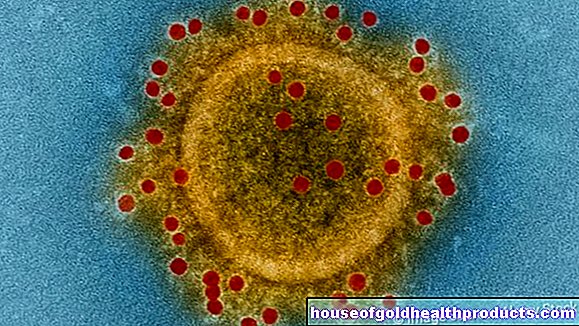




.jpg)

